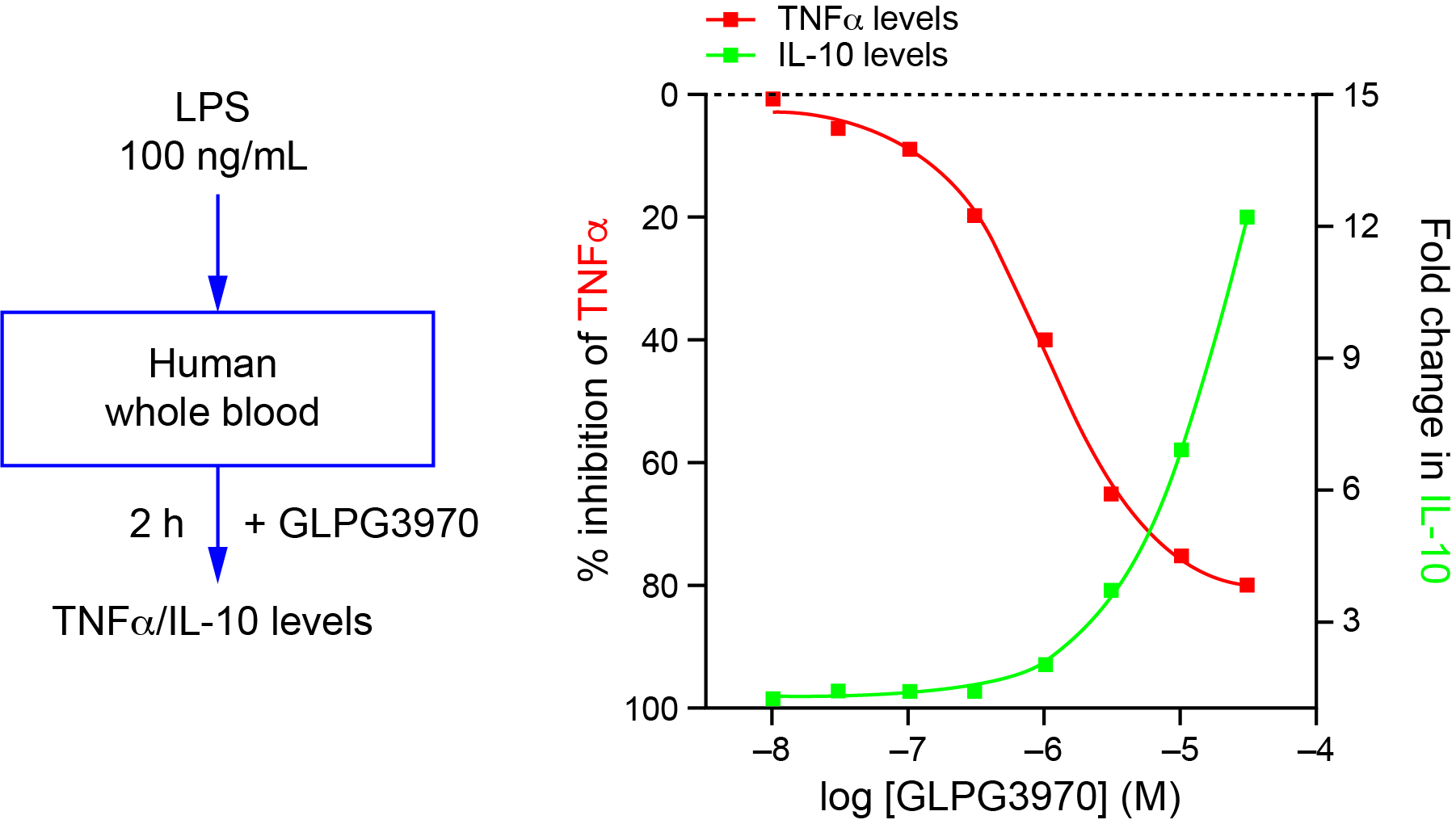Session Information
Session Type: Poster Session C
Session Time: 8:30AM-10:30AM
Background/Purpose: Improved management of rheumatoid arthritis (RA) and psoriatic arthritis (PsA) remains an unmet need. Salt-inducible kinases (SIKs) modulate immune cells by a dual mechanism of action (MoA) in inflammatory conditions.1–3 SIK2/SIK3 inhibition governs a molecular transcriptional switch resulting in reduced expression of pro-inflammatory mediators coupled with enhanced immunoregulatory activity. GLPG3970 is a first-in-class SIK2/SIK3 inhibitor in development for inflammatory indications. We evaluated the therapeutic activity of GLPG3970 in murine arthritis models.
Methods: GLPG3970’s selectivity and potency were profiled in biochemical and target-based cell assays. The dual MoA of SIK2/SIK3 inhibition with GLPG3970 was evaluated in LPS-stimulated human whole blood measuring TNFα and IL-10 release and by performing RNA sequencing. Functional enrichment analysis of KEGG pathways among the differentially expressed genes (DEGs) was performed using a standard hypergeometric test.
Three doses of GLPG3970 treatment were evaluated in two murine models of arthritis: the IL23-induced PsA model and the collagen-induced-arthritis (CIA) model. First, B10.RIII mice received hydrodynamic i.v. injection of 0.1 µg mIL-23 enhanced Episomal Expression Vector to induce PsA disease. Efficacy of 5 weeks of treatment with GLPG3970 was evaluated by clinical score analysis and X-ray imaging (analysis of osteophyte formation). Inflammatory mediators were quantified in paws. Second, in the CIA model, DBA1J mice were classically immunized with a type II bovine collagen emulsion on day 1 and day 21. Efficacy of GLPG3970 treatment from day 32–47 was compared with an anti-TNF agent (Enbrel®) and evaluated by clinical score analysis and bone erosion (Larsen score after X-ray imaging). Anti-collagen type-II antibodies were quantified in serum.
Results: GLPG3970 was shown to inhibit SIK2/SIK3 with high selectivity against a panel of 372 kinases. Activity in LPS-stimulated whole blood led to dose-dependent reduction of TNFα levels coupled with increased IL-10 release (Fig 1). GLPG3970 DEGs in LPS-stimulated whole blood were functionally enriched with RA as part of the top 3 most statistically significant pathways from the KEGG database. GLPG3970 treatment in the PsA model decreased clinical score (Fig 2), osteophyte formation and pro-inflammatory mediators. GLPG3970 reduced clinical score in the CIA model (Fig 3). The highest dose effect was comparable with anti-TNF treatment and correlated with reduced Larsen score and anti-collagen type-II antibody levels.
Conclusion: This study associates the underlying mechanism of SIK2/SIK3 inhibition with RA and highlights the therapeutic activity of GLPG3970 in murine arthritis models, supporting GLPG3970 as a promising novel approach for the treatment of arthritis. GLPG3970 is being tested in a phase 2a study in patients with RA (NCT04577781).
References
1. Clark K et al. PNAS 2012;109:16986–91.
2. Lombardi M et al. J Leukoc Biol 2016;99:711–21.
3. Darling N et al. Biochem J 2017;474:521–37.
 Figure 1: GLPG3970 activity in LPS-stimulated human whole blood assay (mean values, n=52, healthy donors)
Figure 1: GLPG3970 activity in LPS-stimulated human whole blood assay (mean values, n=52, healthy donors)
 Figure 2: Clinical score over time in PsA model (IL_23 induced)
Figure 2: Clinical score over time in PsA model (IL_23 induced)
 Figure 3: Clinical score over time in RA model (therapeutic CIA model)
Figure 3: Clinical score over time in RA model (therapeutic CIA model)
To cite this abstract in AMA style:
Jagerschmidt C, Lavazais S, Colli M, Drennan M, Verschueren E, Amantini D, Desroy N, De Vos S. Preclinical Investigation of the First-in-Class SIK2/SIK3 Inhibitor GLPG3970 in Models of Arthritis [abstract]. Arthritis Rheumatol. 2021; 73 (suppl 9). https://acrabstracts.org/abstract/preclinical-investigation-of-the-first-in-class-sik2-sik3-inhibitor-glpg3970-in-models-of-arthritis/. Accessed .« Back to ACR Convergence 2021
ACR Meeting Abstracts - https://acrabstracts.org/abstract/preclinical-investigation-of-the-first-in-class-sik2-sik3-inhibitor-glpg3970-in-models-of-arthritis/
